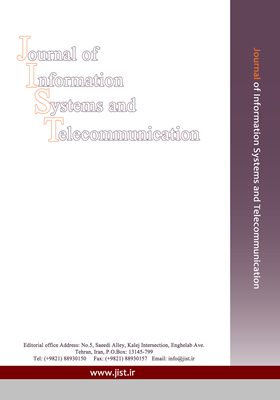Model of Technological, Managerial and Marketing Infrastructure for Intelligent Technology Efficiency in Telecommunication Industry - Case Study: Telecommunication Infrastructure Company of Ilam Province1
الموضوعات : IT StrategyHeshmat morad haseli 1 , Jalal Haghighatmonfared 2
1 - Islamic Azad Tehran center
2 - Islamic Azad Tehran center
الکلمات المفتاحية: Intelligent Agent System , Intelligent Technology , Intelligent Communication , Technological Infrastructure , Management Infrastructure , Marketing Infrastructure,
ملخص المقالة :
Today’s, intelligent agent system (IAS) are considered as an important part of people's lives. Therefore, many of organizations try to implement IAS in their mechanism. One of these organizations in Iran is telecommunication Infrastructure Company. Because any implementation need a model which clarify the structural and contextual components, therefore, the current research is conducted to provide a model for developing the necessary infrastructure for implementation of intelligent technologies in the communication and telecommunication mechanisms of Ilam Province. To achieve the goal, a qualitative approach and thematic analysis method were used. The research population consisted of all experts in the field of ICT in Ilam province Infrastructure Communications Company that using purposeful sampling method and relying on theoretical data saturation, 10 of them were selected as sample. Semi-structured interviews were used to collect the data. The data were analyzed through theme analysis. Based on the method, 4 themes, 10 main categories and 153 open codes were extracted. The findings of the study showed that to transform communication mechanisms into intelligent technologies, there must be technological, management, marketing and cultural infrastructure. Technological infrastructure consisted of intelligent software and hardware; management infrastructure consisted of knowledge and belief; marketing infrastructure included attracting intelligent technology to audiences, encouraging ideas, physical and virtual channels; and finally, cultural infrastructure, it was staff training and public awareness.
[1]. Constantinides, E and Fountain, S. Web 2: conceptual foundation and marketing issues. Journal of Direct, Data and Digital Marketing Practice. Vol. 9, No. 3, 2008, 231-244.
[2]. Mohammed, Ph, Mohan, P. The design and implementation of an encultured web- based intelligent tutoring system for computer science education. The IEEE international Conference on advanced learning technology. 2011, 501-505.
[3]. Mohammadi. Sh. designing the pattern of intelligent learning responding to Cultural diverse of students in Mehr University of alborz. Thesis of educational Management of Tehran University. 2017.
[4]. Ahrens, A; Wen, M, L; Huang, Y; Zascerinska, J and Bassus, O. A comparative study of the relationship between social dimension of web 2.0 technologies and E- learning: students view in German and Taiwan. Paper presented at the 3rd International Conference on Innovation and Entrepreneurship and its implications in Engineering and Business Education, The La Consolacion College Manila, Manila, Philippines, 2010. 16 - 18 November.
[5]. Trannsue, B, M. Connectivism and information literacy: moving from learning theory to pedagogical practice. Public Services Quarterly, 9:3, 2014, 185-195.
[6]. Mercado, J, M; Rupp, M, A; Barbet, D & Procci, K. Intelligent Agent Transparency in Human–Agent Teaming for Multi-UxV Management. Vol. 58, No. 3, May 2016, pp. 401–415.
[7]. Kumar, V; Dixit, A; Rajshekar, R & Javalgi, G. Research framework, strategies, and applications of intelligent agent technologies (IATs) in marketing. J. of the Acad. Mark. Sci. DOI 10.1007/s11747-015-0426-9. 2017.
[8]. Rosenfeld, A; Agmon, N; Maksimov, O; Azaria, A & Kraus, S. Intelligent Agent Supporting Human-Multi-Robot Team Collaboration. Proceedings of the Twenty-Fourth International Joint Conference on Artificial Intelligence, 2015.
[9]. Lemoine, P, M, P; Trentesaux, D; Rey, G, Z & Millot, P. Designing Intelligent Manufacturing Systems through Human-Machine Cooperation Principles: A Human-Centered Approach. Computers & Industrial Engineering, Volume 111, September 2017, Pages 581-595.
[10]. Dermeval, D; Paiva, R; Borges, D; Bittencourt, I, I & Vassileva, J. Authoring Tools for Designing Intelligent Tutoring Systems: A Systematic Review of the Literature. International Journal of Artificial Intelligence in Education volume 28, pages336–384, 2018.
[11]. Lin, Ch, F; Yeh, Y, Ch; Hung, Y, H and Chang, R, I. Developing an intelligent agent for managing web 2.0 services. International conference on future computer supported education. IEPRI, 2, 2012, 738-741.
[12]. Alexander, S, Th, V. An affect-sensitive intelligent tutoring system with an animated pedagogical agent that adapts to student emotion like a human tutor. A thesis presented at Massey University, Albany, New Zealand. 2007.
[13]. Anderson, T and Dron, J. Three generations of distance education pedagogy. International review of research in open and distance learning. 2011, Vol. 12.3.
[14]. Blanchard, E and Frasson, C. Making intelligent tutoring systems culturally aware: the use of Hofstede’s cultural dimensions. HERON Laboratory, Computer Science Department. 2010.
[15]. Brown, S. (2010). From VLEs to learning webs: the implications of Web 2.0 for learning and teaching. Interactive Learning Environments. Vol. 18, No. 1, 1–10.
[16]. Hao. Y & Borich, G. A Practical Guide to Evaluate Quality of Online Courses. In Holim Song & Terry Kidd. Handbook of Research on Human Performance and Instructional Technology. New York: Information science reference. 2010.
[17]. Hixon, E., Barczyk, C., Buckenmeyer, J., & Feldman, L. Mentoring university faculty to become high quality online educators: A program evaluation. Online Journal of Distance Learning Administration, 2011, 14 (5).
[18]. Kaplan, A, M and Haenlein, M. Higher education and the digital revolution: About MOOCs, SPOCs, social media, and the Cookie Monster. Business horizon, 2016, 59, 441- 450.
[19]. Kazemifard, M; Ghasem- Aghaee, N and Oren, T. Emotive and cognitive simulation by agents: roles of three levels of information processing. Cognitive systems research, 2011, 13, 24-38.
[20]. Rocker, C; Janse, M; Portolm, N and Streitz, N. User requirements for intelligent home environments: A scenario-driven approach and empirical cross-cultural study. Published in: proceeding of the 2014 joint conference on intelligent objects and ambient intelligence, 2014, 111-116.
[21]. Mazadi, Z; Ghasem Aghaee, N and Oren, T. Prelude to cultural software agents: cultural backgrounds in agent simulation. Conference: Proceedings of the Spring Simulation Multi conference. 2008, 135-142.
[22]. Creswell J. w. Educational research: planning, conducting and evaluating quantitative and qualitative research. (Fourth edition). Pearson. Boston. 2012.


